The information that we are going to share with you today is reserved for the basketball geeks and freaks only. Or, should I say that the information of this level of basketball can only be interesting to real basketball lovers who just want to know it all.
Where everybody is trying to teach you how to jump higher, we are going to go one step further in our analysis just to try to explain to you the physics of the move. It is very important to know all the forces that are involved in the sequence of movement that is lifting our body up in the air. We are going to talk about some pure physics of jumping and we will mix it with the biomechanics stuff in order to interduce you with another aspect of your body.
We are going to talk about 5 phases that our body is going through in the act of jumping:
- Preparation for the jump
- Drop before the jump
- The upward motion before the Takeoff
- The Flight
- The Landing
Preparation for the jump
Whatever we do on this Planet, we have to be aware that there is a gravity force affecting our body. That simple force is pulling is towards the center of the earth no matter what we are doing. We all know that the gravity has a force of g=9.81m/s2 and if we want to jump, we need to produce force bigger then the gravity itself in order to be able to take a flight. The more force we produce the bigger the jump is.
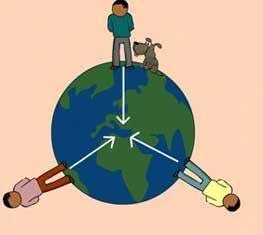
The instrument invented to measure the impact of ground forces on a body are called force plates. In this video on Youtube you can see what it looks like and how it works:
As we can see in the video, first there is a steady flat line which means that when we do nothing, the gravitational force that affects our body, and the force that our body is using to oppose the gravity are canceling each other, and that is exactly what the third Newton law is telling us: „To every action, there is always opposed an equal reaction.”
The first change that we can notice is the Downward movement on the scale.
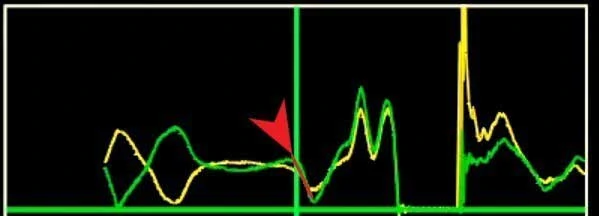
What this means is that in the first act of the preparation for the jump, our body is going away from the ground. The jumper is getting his knees bent, he is swinging his arms and lowering the center of the gravity all at the same moment.
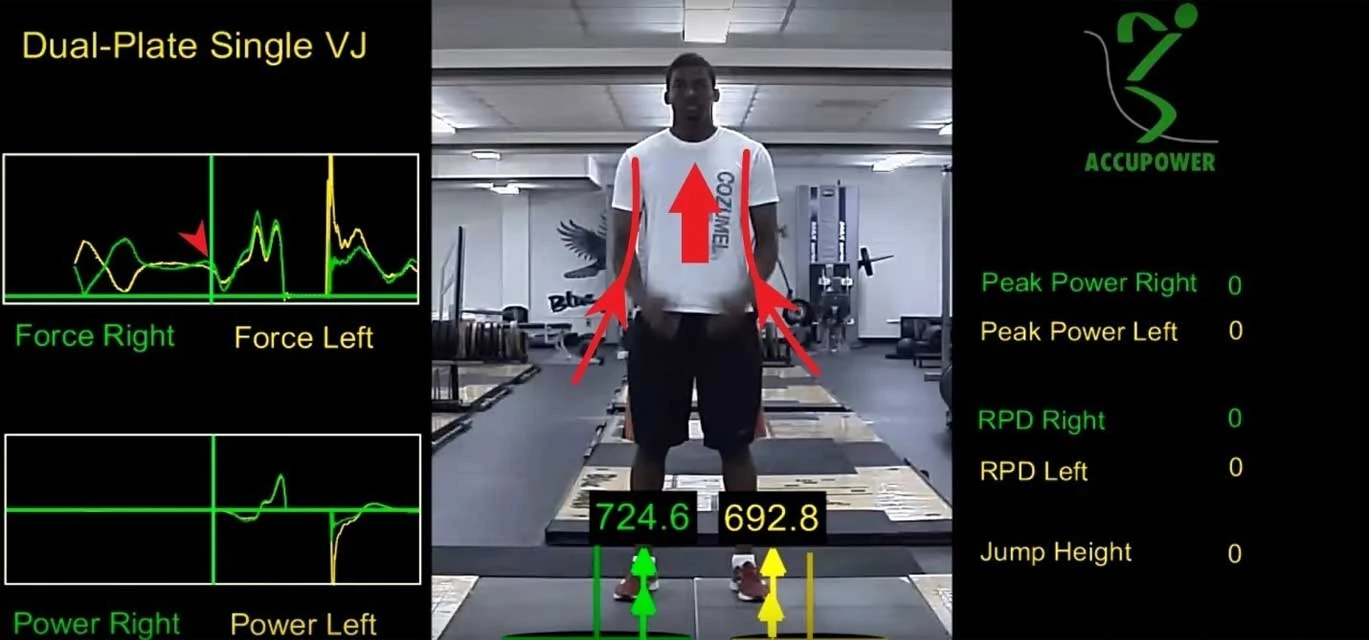
f we take a look, the force that our jumper afflicts on the ground is around 710 average. So in the declining phase, a force that he is producing on the ground is lower than 710.
The forces that act at this time can be described by the formula:

One of the aspects of an advanced training is how fast can athletes get down in the act of jumping, and there is a great improvement in the performance when this aspect of the whole move get faster.

Because the Force is not a constant, but rather in function of time, then we can conclude that:

Where the Force of the Jumper is the difference between the registered ground forces and the gravity.
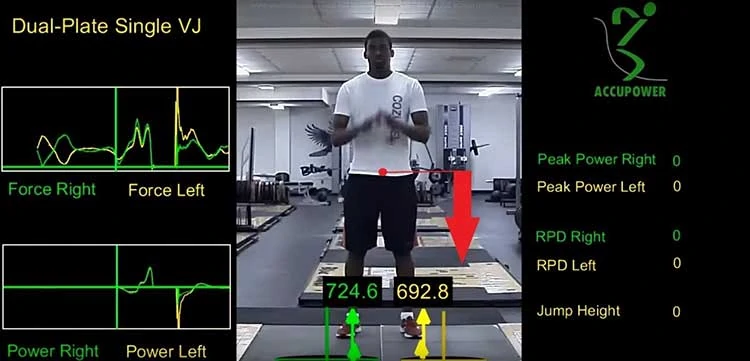
If we know that our jumper weights around 72 kg and the integral impulse of decline is -70 Ns, then if we go to the equation we will find that the speed of decline is 1.01 m/s.
Drop Before the Jump
In this phase, we have a major preparation for the jump. First, the arms are getting behind us, knees are getting more bent and our center of gravity is reaching its lowest point. As the jumper is going down, the line is on the diagram is getting up which means that we are maximizing the force that our body is emitting towards the ground
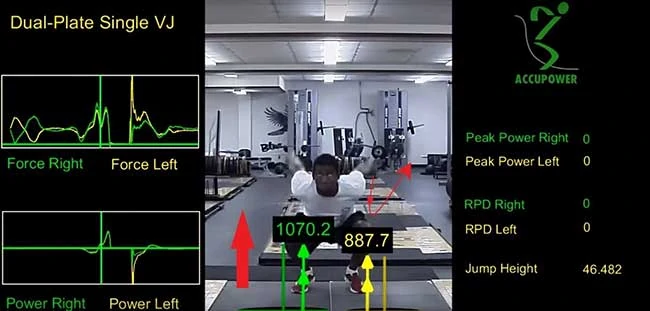
As we can see, the jumper is emitting a force of 1000N (average), which is 30% more than while standing still.
If we break down the move and observe the muscles, here is what are we going to find in the downside of the body:
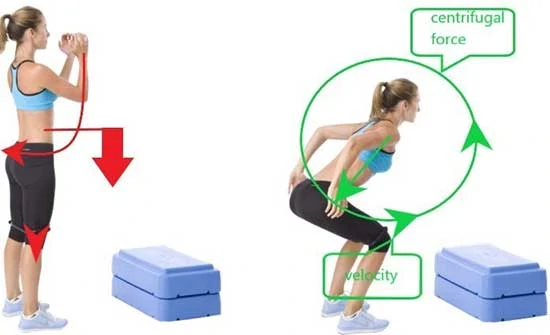
If we take a look, in the first phase we have the arms going down and toward the back, then we have the knees bending and we have a motion where the jumper is lowering his center of gravity. The faster he goes down, the more force he creates that is emitted to the ground. (RED POINTERS)
The second picture is showing us a moment where the downward phase has ended, and when the jump actually is going to start. As it is shown in the picture, the first move that unlocks the sequence is the arm swing. By moving the arms in the circular motion, the jumper is creating the velocity in the hands, because there is centrifugal force created from the shoulder toward the hand.
An Upward Motion Before the Takeoff
This is the phase of the jump where every muscle in the body is cooperating and all that with only one cause: to get the body off the ground.
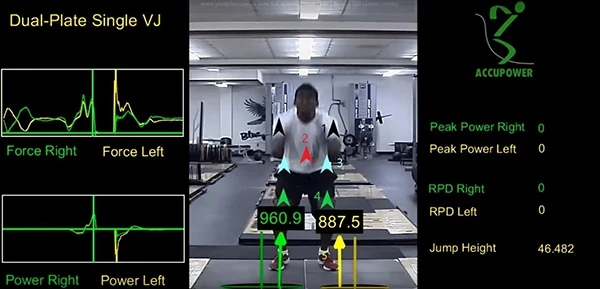
The sequence of muscle involvement:
- Arms swing from the back, down and then up, creating velocity and pulling the body upwards.
- Abs are going from a crunched to a stretched state.
- Hips are going forward
- Ties are contracting and pushing the body off of the ground
- Hills are getting lifted and there is an instant contraction of the rear lower leg muscles
If we want to calculate the velocity that the body creates during the jump, then we are going to use the next formula:

The algorithm is saying to us that the impulse created in the act of jumping is 245 Ns. If we use this number in the algorithm, then we are going to have:
245 Ns = 72 kg X v, so v=245 Ns/72 kg, v =3.4 m/s
The Flight
After the jumper has lost the contact with the ground, there are no other forces acting upon him rather than the gravity which is pulling him towards the ground. The hight of the jump was predetermined by the velocity formed in the act of upward motion.
If the athlete wants to improve his jump, then he should work on the preparation for the jump, he should consider all the muscles involved and all the forces created.
The things that we know now is that the gravity of the earth has the acceleration of 9.81 m/s and that the body of the jumper created the velocity of 3.4 m/s. If we know these two things, now we can calculate the velocity during every moment of the jump.

If the V at the peak is 0, then, velocity in every moment is:

The time that is needed for the jumper to reach the peak is calculated like this:
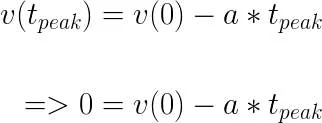

As we can see, now we know the velocity during every moment of the jump, and the time of the peak is 0.34s, which all leads to the conclusion that we have the material to calculate the height of the jump:
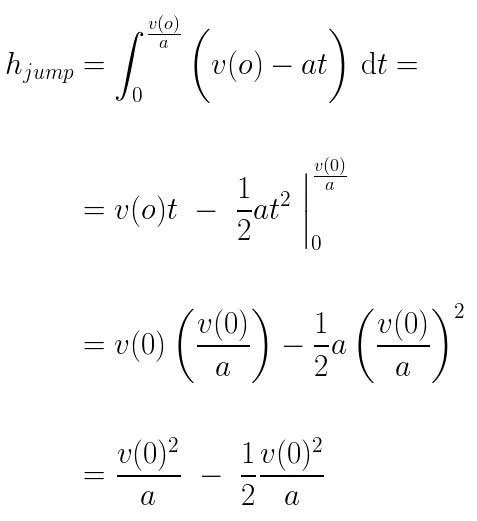
So now, we have a pretty simple formula to calculate vertical jump hight. The result is 56 cm.
The Lending – Important Part of Vertical Jump
As it is shown on the graphic, the velocity created diminish at the peak of the jump, so its value is then 0. The velocity in the act of the landing is the same as the one created in the act of jumping, but because the body is now traveling in the opposite direction, the number is -3.4 m/s. The change of speed is 3.4 in both cases, so when the jumper hits the ground he comes to a standstill position. At this moment, all of the 5 phases of the jump are done and the move is over.
Well, as we now explained all of the phases of the jump, we exactly know how the move works. All this knowledge needs to be practically reconsidered in order to be used in training and designing the drills. The whole point of the story is that the athlete if he wants to get better in jumping, needs to be able to create more velocity
The velocity is going to rise in two cases:
- Getting your muscles stronger
- Losing some weight
These two claims are not much complementary. Muscles are made of fibers, and the bigger fibers can produce more force. Bigger muscles mean more overall mass, but there is a catch. Muscles are able to get stronger in a certain percent without enlarging its muscles. The main thing that today’s players need to work on his conditioning while taking care of body fats.
So, if you want to jump higher, the first thing that you need to do is that you need to go to the gym and get those muscles bigger and stronger. Then, when you are all riped up, then it is time for plyometric jumps and the construction of the muscle memory.
How does defferent age groups jump
For this particular test, we took 4 test groups. The difference between the groups is in the age of the participants. The first group contains the children that are from 2-6 years old, the second group is 7-12 years old, the adolesence group is the third one and kids are 13-18 years old, and the last group is a 60+.
If you take a closer look, we didn’t analyze the people that are between 18 and 60, just because their body is fully developed and the variations between the jump ability are only conditioned by the fact if the subject is working on his leap or not.
1. Early Childhood (2-6 years old):
The average age that the children are starting to jump is about when they turn 2. This is the age when the human body is reaching the potential to propel its body in the air. The move by itself is a complex sequence that requires so many locomotive processes to act in a fully coordinated manner. One of the first requirements that a child has to meed is the muscle strength. The second thing that needs to form is the coordination between the quadriceps, gluteus, and the hamstrings. These muscle groups are the main means that our body uses to lift itself in the air.
For this age group, the thing that is most common for all the participants is the little to none preparation for the jump. The knees are not bent much, so there is less contraction of the muscles so the capacity of the support system is not maximally utilized.
In the perfect preparation for the jump, and if we are talking about the legs, the best performances are reached when the angle between the upper and the lower leg is from 90-120 degrees. The books say that while the knee is bent at these angles, the ideal amount of actin-myosin overlap occurs for maximal force production.
Another thing is notable for this age group, and it is the complete absence of the arm swing. We all know that the jump starts with the rotation of the arms from back to front and then up in the air and that this centrifugal force is pulling the body up in the air.
If we observe the coordination of these children while they jump, we will see that their limbs are all in their own track in a completely uncoordinated manner. There is a slight disbalance between the legs both while taking off or landing.
One more thing that is obvious is the stiffness in the joints and the move itself does not have a natural flow.
2. Later Childhood (7-12 years old):
This age group is jumping a bit better than the younger one. They have better preparation but it is far from good. While they flex the knees more than the kids that are from 2-6 years old, there is still little to none lower limb muscle action. Calf muscles don’t contract much and the foot is flat and it sticks to the ground with its all surface during the whole time.
The body stance of these kids while preparing for the leap is all wrong. They are bent a bit forward, very similar like the posture that professional jumpers have when they want to jump forward. This mistake is a consequence of not being taught how to jump vertically rather than any other reason. In this age, kids can understand the mechanics if it’s presented to them the right way so we can say that this group is perfect for the start of the training process.
Even if those kids are not taught how to jump, we can see a big progress symmetry wise. These kids have more coordination then the younger group even if they didn’t practice vertical jumping ever in their life.
The amount of arm movement is better but not good. These children keep the elbows close to their body and the swing angle is about 90 degrees (270 is at the full swing). One more interesting thing has been noticed. While the boys and girls have their arm swing, there is a disparity in terms that the dominant hand is taking a bigger load. Kids are swinging their dominant hand harder while jumping.
3. Early adulthood (13-18 years old):
In this group, we can notice a great deal of improvement in their vertical jump technique. The arms are getting in the right kind of behind the back position and the knees are even more bent. Next what is notable is the activation of the calves and foot, while the whole motion is more fluid and meaningful.
In the preparation part, as the arms start their motion from far back, there is a little drop in the crunch even further just to make the most tension in the muscles for the push of.
Even the kids that never trained anything that involves vertical jumping are doing the drill the right way because they seem to understand the whole point of jumping.
With constant practice and training, while the muscle mass and strength are increased, there is the advancement in coordination and neuromuscular activation around each lower limb joint. In compartment with the previous age group, one more difference is obvious and that is the development of the fast – twitch muscle fibers. That new feature allows muscle groups to act even faster and to create bigger force needed to throw the body in the air.
4. 60+ age group:
In this age group, we can see that there is a revert process where there is a decrease in jumping ability. As the body gets older the mass of the muscles decrease and the joints become stiff. The arm movement becomes limited so the swing part is incomplete. Same goes for the knees: older people cant crouch enough.
While we have the decay with the muscle straingt, the neuromuscular part is still good. Posture, synergy, coordination, they are all good.
Also, we can see that the fast twithc fibers have lost their power so there are no explosive moves.
With all that being said, it is imminent that there is a decrease in jump height.
Conclusion
The absence of a good preparatory movement is evident in the early childhood age group. With both the 3-year-old and 11-year old small amount of knee and hip joint flexion is observed. Failing to attain optimal jump angle at the knee area (90-120 degrees) limits the muscle’s ability to perform at maximal capacity generating a sub-maximal force.
Both age groups, demonstrate insufficient arm movement while the 3-year-old shows no signs of using an arm swing during the preparation phase and the arms are kept to the sides of the body while airborne.
Similar inadequate arm use is demonstrated by the 11-year-old; the arms remain flexed at a 90-degree angle throughout the crouch, takeoff, and landing. Slight right shoulder abduction is also observed as the boy approaches peak jump height. Hayden & Getchell (2014) explain similar movement patterns between the two age groups.
In early adulthood, we see the appearance of an efficient preparatory crouch. The 16-year old jumper attains knee flexion within the optimal 90-120 degree range allowing full extension the ankles, knees, and hip joints at takeoff. Similar joint flexion is seen with the 64-year-old jumper. Literature shows that with increased coordination and muscle strength in early adulthood the lower leg muscles have an increased ability to lengthen.
In addition, both adult age groups demonstrate the use of an arm swing to propel the body vertically upward. However, both members within these categories limit their arm flexion to mid-range failing to complete the overhead portion of the arm swing at peak jump height. The preparatory crouch used by both age groups is evident in proficient jumpers, while the lack of overhead arm movement is mostly a characteristic seen in the younger age groups.
In conclusion, each age category clearly reveals an evolving sequence of development as the time passes. The body matures and increases in muscle mass and coordination allows individuals to perform a vertical jump at a more proficient biomechanical level. Faults in technique in early and late childhood can be attributed to underdeveloped muscle mass, decreased coordination and lack of experience with performing the vertical jump.
Source:
Analysis of Standing Vertical Jump – Nick Linthorne
https://www.brunel.ac.uk/~spstnpl/Publications/VerticalJump(Linthorne).pdf
